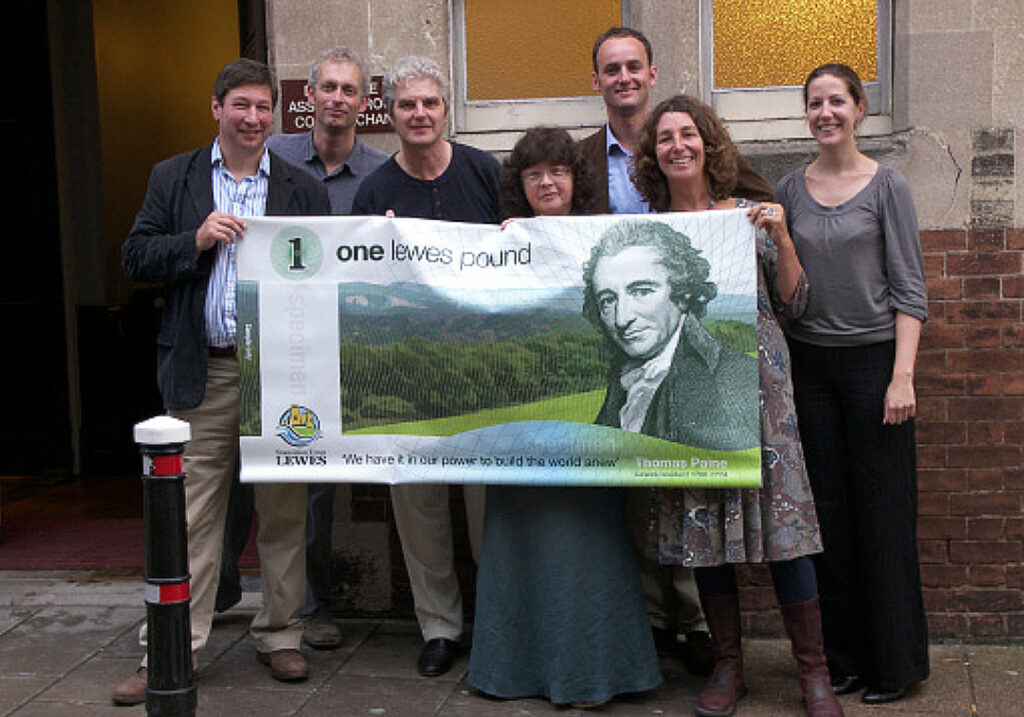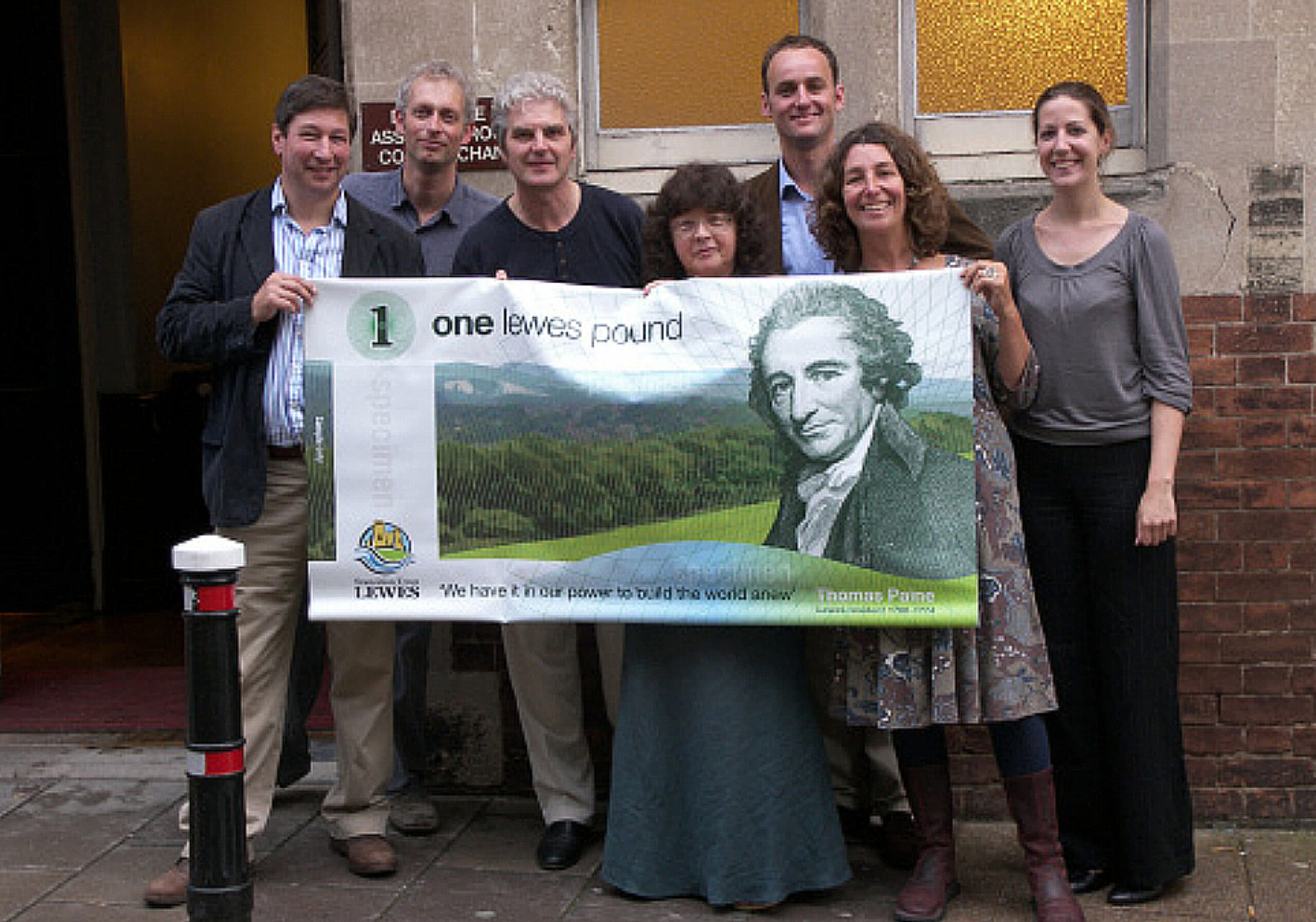| Original Location | Totnes, United Kingdom |
| Date | 2006-present |
| Reach | 380 communities in 31 countries |
| Concept | Naresh Giangrande, Rob Hopkins |
| Major Funders | Albert van den Bergh Charitable Trust ; Ashden Trust; Calouste Gulbenkian Foundation; Esmee Fairbairn Foundation; Funding Network; Marmot Charitable Trust; Polden-Puckham Charitable Foundation; Tanner Trust; Tudor Trust |

Transition Town residents hold up an enlarged “Lewes Pound,” one of several local currencies. Photo: Mike Grenville
The earth’s oil supply dries up, world climates spin out of control, and the human race struggles for survival. It sounds like the perfect plot for an apocalyptic blockbuster, but some scientists say it will really happen. Rob Hopkins, a British instructor of ecological design and co-founder of the Transition Initiative movement, believes some of these things could happen. In preparation, Hopkins developed a 12-step program to transition the rural English town of Totnes from oil dependency to “self-resilience.”
With a population of 8000 people, Totnes is the first town to embrace the Transition Movement and “brace itself to withstand the shocks that will come as oil grows astronomically expensive, climate change intensifies, and maybe sooner than we think, industrial society frays or collapses entirely,” Hopkins says, cheerfully explaining a theory known as peak oil.
A modern day Buckminster Fuller, Hopkins shares the late inventor of the buckyball’s knack for tinkering, but with a strong social policy streak. The idea for the Transition Initiative started with a question: What happens if we look at peak oil through permaculture design principles? Permaculture, according to its co-originator David Holmgreen, is a design system for human settlements and agricultural systems based on three ethics—caring for the earth, caring for people, and fair sharing of resources. It aims to mimic the natural environment to create sustainable communities that are less dependent on fossil fuel and the global economy.
The Transition Movement is a large-scale social experiment aiming to build local resilience, essentially making a community more self-sustainable in transportation, agriculture, energy production and water use. The framework of Totnes provided a platform for innovative ideas, projects, and businesses to be recognized and imitated. The Transition Network Website lists all 380 cities, towns and villages in the Transition Network on a map with contact details for people who want to get involved. If there are none nearby, the site offers a handbook for starting a Transition Town, as well as books about local resiliency, food, money and sustainable homes.
There are 12 steps to creating a Transition Town: setting up a steering committee that plans its own demise; creating awareness; laying foundations through networking; organizing a “Great Unleashing,” or launch party; forming working groups to focus on areas such as food and waste; using existing open space; developing visible and practical manifestations of the project; facilitating the reskilling of the local community; building bridges with local governments; honoring elders; allowing the projects to grow organically; and finally, creating an energy descent plan.
An Energy Descent Action Plan moves a community from oil dependency to sustainable energy use and production. The community-owned Totnes Renewable Energy Society is planning two new energy production facilities, a wind farm with two 2.5 megawatt wind turbines that will power 2500 homes, and an anaerobic digestion plant (biodigester) that burns methane and carbon dioxide created from bacteria-treated waste.
Totnes also created a unique local currency that holds the same value as a British pound to bolster its economy by keeping more money within the community. Fifty local businesses have agreed to accept the new currency.
“We first saw Transition [Towns] as an environmental initiative, but we increasingly think of it as a cultural initiative,” Hopkins says. “It’s about how you shift culture to a place that is prepared for economic contraction and oil shocks, and seeing it as an opportunity and not a disaster.”
The result is an organization that guides the community, allowing individuals to create their own solutions, rather than having an outsider telling them what to do. This means that no two Transition Towns are the same. “It has been hard to measure the impact of an initiative in its entirety,” Hopkins explains. “But here in Totnes we just did Transition Streets, which is about street-by-street behavior change.” The Transition Streets project brought together 60 groups made up of six to eight households that met seven times to figure out ways to reduce their energy and water use. Every household reduced its carbon by about 1.5 tons and saved £700 ($1136 USD) per year, according to Hopkins, who says an added benefit of the Transition Town model is getting to know neighbors and community members better.


left image: Rob Hopkins speaking about Transistion Towns. Photo: Mike Grenville
right image: The Transition Handbook, published by Green Books. Image: Chelsea Green
















READ OR LEAVE A COMMENT